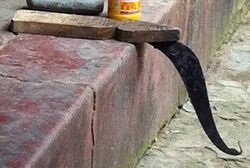Engineering:Paniki (cutting instrument)

Paniki is a traditional East Indian (Mostly Odisha) tool with a cutting edge with a wooden footrest.[1] Panikis are used in the kitchen for chopping vegetables, fish and meat.[2] Panikis are mostly found in Odisha, India [3] and the variations of the tool is known as Boti in West Bengal and Tripura in India and in Bangladesh. Various tribes of Odisha used for different purposes. The tribe members of the Mutkia Kondha worship paniki as deity and do not keep their feet with their feet. They rather use a special type of paniki with a wooden stand.[4] Panikis of ancient times show engraving of cultural and religious elements.[5] Traditionally in rural Odisha, panikis are made from wrought iron or recycled steel by the blacksmith.[6]
In popular culture
In murals of the Ushakothi cave painting at Ulapgarh depict the use of paniki being used by a woman.[7]
References
- ↑ Gopinath Mohanty; Jeeban Kumar Patnaik; Santosha Kumāra Ratha (2003). Cultural heritage of [Orissa]. State Level Vyasakabi Fakir Mohan Smruti Samsad. ISBN 978-81-902761-4-6. https://books.google.com/books?id=e7ZKAQAAIAAJ.
- ↑ India. Office of the Registrar General (1967). Census of India, 1961: Orissa. Manager of Publications. https://books.google.com/books?id=wwAfAQAAMAAJ.
- ↑ Orissa (India). Harijan & Tribal Welfare Dept (1990). Tribes of Orissa. Harijan and Tribal Welfare Department, Government Of Orissa. https://books.google.com/books?id=yStuAAAAMAAJ.
- ↑ Angelika Malinar; Johannes Beltz; Heiko Frese (1 September 2004). Text and context in the history, literature, and religion of Orissa. Manohar. ISBN 978-81-7304-566-0. https://books.google.com/books?id=9Y0MAQAAMAAJ.
- ↑ Dinanath Pathy (1990). Traditional Paintings of Orissa. Working Artists Association of Orissa. https://books.google.com/books?id=GAnrAAAAMAAJ.
- ↑ Nab Kishore Behura (1978). Peasant potters of Orissa: a sociological study. Sterling. https://books.google.com/books?id=r-AcAAAAIAAJ.
- ↑ Eberhard Fischer; Dinanath Pathy (1996). Murals for goddesses and gods: the tradition of Osakothi ritual painting in Orissa, India. Indira Gandhi National Centre for the Arts. https://books.google.com/books?id=8Y3pAAAAMAAJ.
 |
